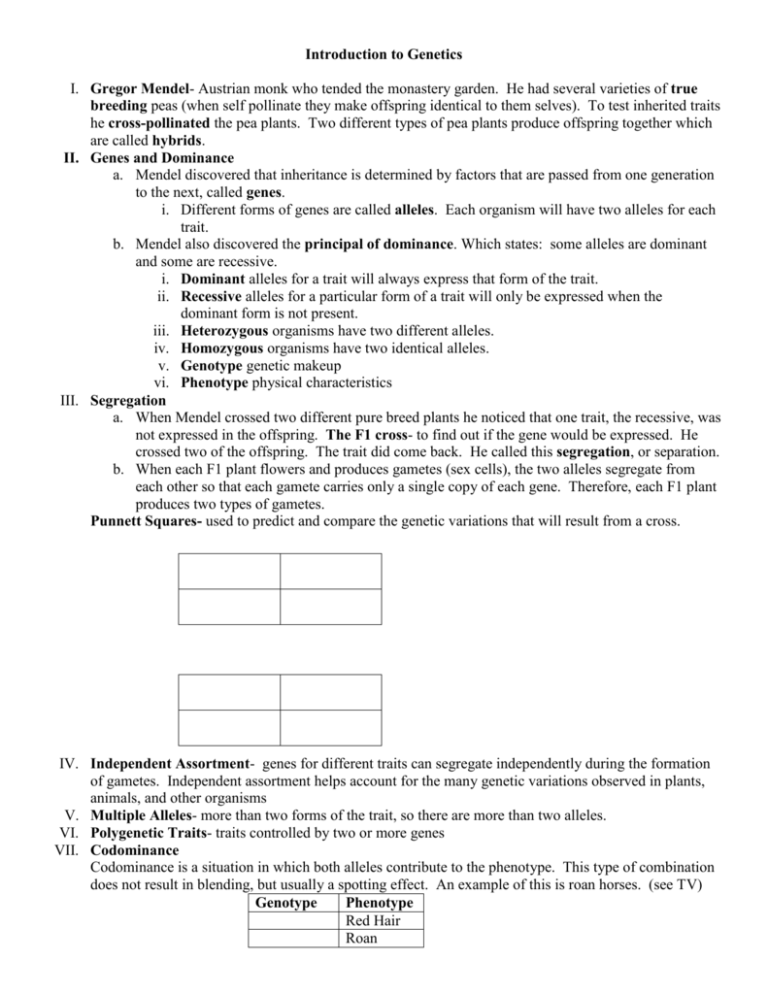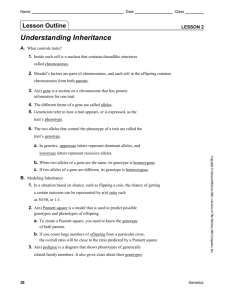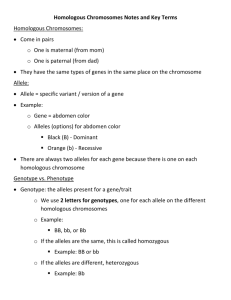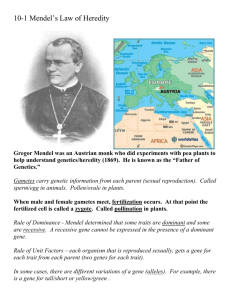Introduction to Genetics
advertisement

Introduction to Genetics I. Gregor Mendel- Austrian monk who tended the monastery garden. He had several varieties of true breeding peas (when self pollinate they make offspring identical to them selves). To test inherited traits he cross-pollinated the pea plants. Two different types of pea plants produce offspring together which are called hybrids. II. Genes and Dominance a. Mendel discovered that inheritance is determined by factors that are passed from one generation to the next, called genes. i. Different forms of genes are called alleles. Each organism will have two alleles for each trait. b. Mendel also discovered the principal of dominance. Which states: some alleles are dominant and some are recessive. i. Dominant alleles for a trait will always express that form of the trait. ii. Recessive alleles for a particular form of a trait will only be expressed when the dominant form is not present. iii. Heterozygous organisms have two different alleles. iv. Homozygous organisms have two identical alleles. v. Genotype genetic makeup vi. Phenotype physical characteristics III. Segregation a. When Mendel crossed two different pure breed plants he noticed that one trait, the recessive, was not expressed in the offspring. The F1 cross- to find out if the gene would be expressed. He crossed two of the offspring. The trait did come back. He called this segregation, or separation. b. When each F1 plant flowers and produces gametes (sex cells), the two alleles segregate from each other so that each gamete carries only a single copy of each gene. Therefore, each F1 plant produces two types of gametes. Punnett Squares- used to predict and compare the genetic variations that will result from a cross. IV. Independent Assortment- genes for different traits can segregate independently during the formation of gametes. Independent assortment helps account for the many genetic variations observed in plants, animals, and other organisms V. Multiple Alleles- more than two forms of the trait, so there are more than two alleles. VI. Polygenetic Traits- traits controlled by two or more genes VII. Codominance Codominance is a situation in which both alleles contribute to the phenotype. This type of combination does not result in blending, but usually a spotting effect. An example of this is roan horses. (see TV) Genotype Phenotype Red Hair Roan White Hair Cross a red horse and a white horse: Cross two roan horses: What is the probability of producing a white horse from this match? Cross a roan and a white horse: What is the probability of producing a white horse from this match? VIII. Incomplete Dominance Incomplete dominance is a situation in which both alleles contribute to the phenotype. In this cross, the parents alleles blend together and the offspring have a phenotype somewhere between their parents. (see TV) Genotype Phenotype No sickle cell anemia, malaria prone No symptoms of sickle cell, but resistant to malaria Sickle cell anemia expressed Cross two parents that are heterozygous for sickle cell anemia: What is the likelihood that this couple will produce offspring that are resistant to malaria? Cross a parent with sickle cell and a parent with malaria: IX. Multiple Alleles Multiple alleles occur when a gene has more than two possibilities. This does not mean that an individual can have more than two alleles. Only that more than two possible choices exist. One of the best known examples is found in rabbits, another is human blood type. (TV) Blood Type (Phenotype) O AB A B Genotype Can donate blood to: Can receive blood from: A,B,AB and O O, AB AB, A AB,B O A,B,AB and O O,A O,B Cross a female with type O and a male with O: Cross a female with type A and a male with B: (Hint their daughter has type O blood!) A man with AB blood marries a woman who says she is carrying his child. The child is born with type O blood. Can this be his child? A child has type O blood. His mother is type B, his father is type A, and his brother is AB. How is this possible? X. Sex-linked Genes Sex-linked genes are found on the X chromosome. More than 100 disorders have been linked to the X chromosome. The Y chromosome is very small and contains only a few genes, including the sex determining factor. Males have just one X chromosome , so all X-linked alleles are expressed even if they are recessive. Examples of sex-linked genes are: Colorblindness (recessive) Hemophilia (recessive) Hearing loss (dominant) XI. Dihybrid Cross Dihybrid crosses are punnett squares involving two traits at the same time.







